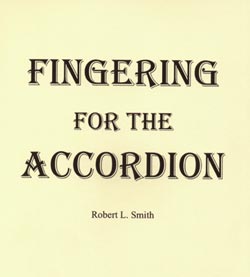Book Review: Fingering for the Accordion
Author: Robert L. Smith

Published: 2005 Order Information:
|
Contents:
|
Review by: Robert Stead
More is lost through poor fingering than can be replaced by all conceivable artistry and good taste.
--C. P. E. Bach (quoted by Robert L. Smith)
In a succession of notes, always watch to see what follows and choose a fingering which will make the progression smooth and easy. Develop equal facility with all five fingers.
--Juan Bermudo, Declaraci˛n de instrumentos musicales, 1555
After playing flute for 40 years, I decided to return to the accordion. With the onset of adolescence (and the desire to play in the high school band) I had left the accordion behind. I had just begun Palmer's 5th book when I walked away from the world of free-reeds. Although I had abandoned it, I always loved the accordion's tone and potential. So, in the Spring of 2003 I bought an Excelsior 980 free bass accordion and started to practice.
I quickly encountered the challenge of fingering. I realized that I lacked a good guide to the world of fingering possibilities. While I did purchase the Hanon for the Accordion books, I felt that there had to be more to fingering than the standard fingering patterns designed for the piano. In fact, it didn't quite make sense to me to use the piano as the exclusive model for technique since the accordion is actually an organ and not a piano. My studies led me to a book entitled Method of Organ Playing--Eighth Edition by Harold Gleason. Here I discovered that fingering for keyboards has a rich 500 year history. To determine correct fingering patterns you need to consider the type of keyboard, the shape of the hand, and the style of the music. In other words, there are many paths one can travel in the pursuit of the "correct" method of fingering.
Robert L. Smith's Fingering for the Accordion explores several of these paths. He begins his book by emphasizing that the piano accordion is not a piano. Therefore the accordionist should not rigidly follow those fingering patterns that have been established for the piano. The piano accordion's vertical keyboard orientation presents challenges to the accordionist's hand and wrist that do not exist for the pianist. Furthermore, the non-percussive nature of the accordion makes organ technique more applicable than piano technique--especially for legato passages.
Fingering for the Accordion presents not only the standard fingering patterns for scales and arpeggios for the piano accordion, but also many alternative fingerings that can help the accordionist experiment with different approaches. Listed below you will find the areas of concentration for the treble keyboard.
In his discussion on parallel scales, Mr. Smith provides a very useful section on organ techniques. Smith states:
- Eleven basic fingering techniques
- Major and minor scales in all keys with standard and alternative fingerings
- Four methods of playing the chromatic scale including the new 3+4 method
- Thirds on major, minor and chromatic scales
- Techniques for playing parallel scale passages
But the best technique for playing thirds in legato style is taken from classical organ methods. This is very useful, but appears to be unknown to most accordionists. [page 22]He then describes what he calls the "side-winder" method and the "spider" method of fingering which involves envisioning each key as having two distinct zones and then moving from zone to zone.
The author also includes several fingering patterns for the standard bass accordion such as:
For the bass chromatic scale variations, Smith draws upon fingering patterns used by Deiro, Nunzio, Magnante, Gall-Rini, and Stricker. In his discussion on legato bass chord combinations, he first uses a fingering example from Galla-Rini and then proposes two alternative fingerings to accomodate different hand sizes.
- 5 fingerings for major scales
- 3 fingerings for harmonic minor scales
- 3 fingerings for melodic minor scales
- 8 fingerings for the chromatic scale
- Alternate fingerings for bass/chord combinations
- Diminished chord variations
- Use of the thumb on diminished chord buttons
If you are looking for a book that will expand your approach to fingering and that will guide you into exploring fingering alternatives that best suit the size of your hand, then I highly recommend Fingering for the Accordion. Mr. Smith does a fine job of proving that there is more than one way to play a scale, arpeggio, or chord. This work encourages one to experiment to find the best fingering for the passage at hand. As Juan Bermudo said almost 500 years ago: "Always watch to see what follows and choose a fingering which will make the progression smooth and easy." Fingering for the Accordion will help you make that choice.
| About The Free-Reed Review |
| Invitation to Contributors / Submission Guidelines |
| Back to The Free-Reed Review Contents
Page |
| Back
to The Classical Free-Reed, Inc. Home Page |